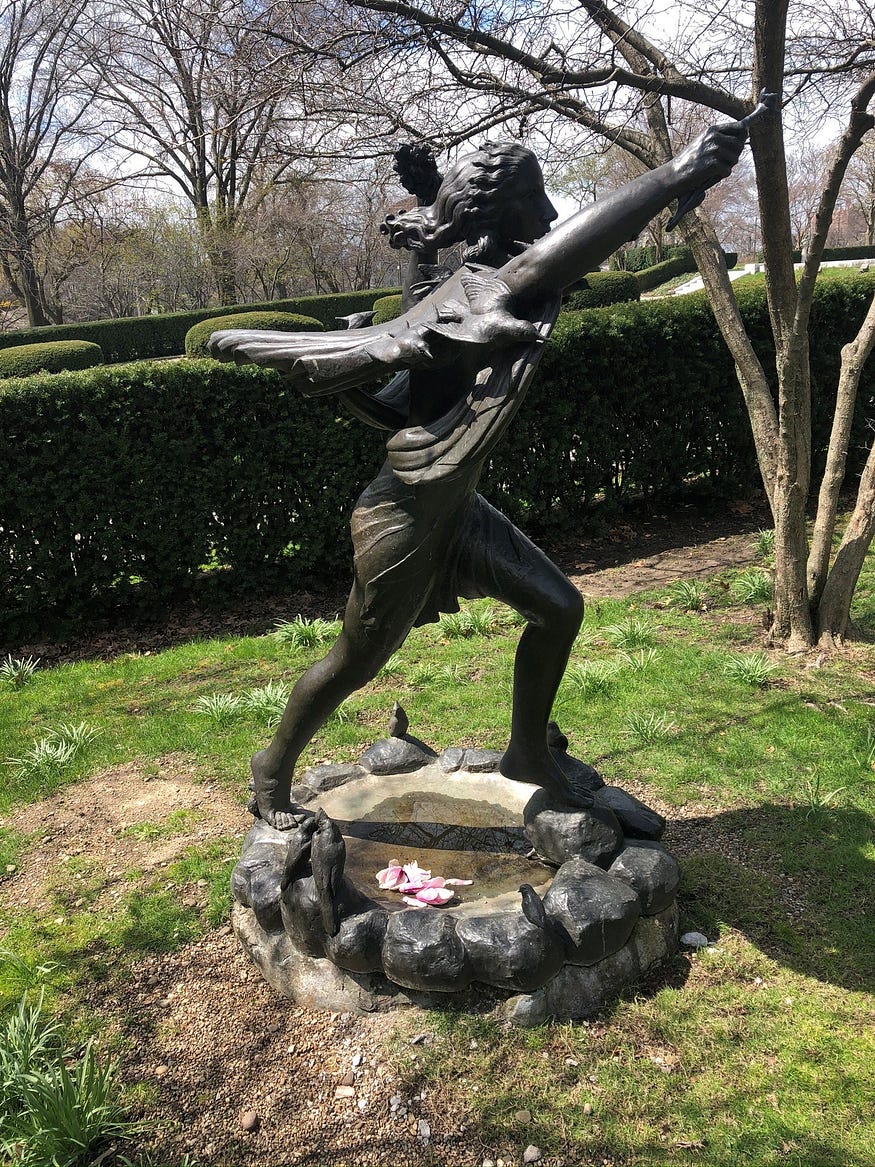Find the Art among the Cherry Blossoms
Tags for: Find the Art among the Cherry Blossoms
- Blog Post
- Building and Grounds
Bentley Boyd, Donor and Member Communications Manager
April 17, 2020


The two global pandemics that forced the closure of the Cleveland Museum of Art came in different seasons. The 1918 flu forced the museum to close for three weeks in October and November. In those chilling days, people drew hope from a cease-fire of World War I’s bloodshed and from traditional holidays of harvest thanksgiving.
Now the social isolation forced by the COVID-19 crisis comes as spring days grow brighter and warmer. The weeping Japanese cherry trees surrounding Wade Lagoon have opened their blossoms of pink and white. Their color is one of the heralds of spring in Cleveland, and many call this area south of the museum the most beautiful spot in the city. A visit to the Fine Arts Garden at a safe social distance affirms the past spring seasons at the CMA and all the spring seasons to come.

When the CMA opened in 1916, its construction left the surrounding land untended and unbefitting the marbled institution. The famous landscape architecture firm of Frederick Law Olmsted Jr. was hired to shape the space between the CMA’s formal south entrance and busy Euclid Avenue.
Jeffrey Strean, the museum’s former director of design and architecture and currently a design consultant to the CMA, said that between 1925 and 1928 the firm “framed the Fine Arts Garden at either end of the lagoon with these formal elements, but in between was this kind of romantic notion of what a natural landscape would be — which is not a natural landscape! But they created a really beautiful thing.”

If you go to get fresh air among the cherry trees, a start at the East Boulevard entrance is framed by Art (1972/2011), a polychrome aluminum sculpture by American Robert Indiana. In normal times, its bright red and sharp lines grab the attention of busy people. In these quiet COVID-19 days, the unnatural colors this sculpture brings to the landscape make it a loud proclamation that art is still here.

From this gateway, visitors gravitate to Auguste Rodin’s The Thinker (1880–81), centerpiece of the CMA’s majestic South Terrace. Originally conceived to top Rodin’s sculptural door The Gates of Hell (c. 1880–90), this enlarged version of The Thinker is one of fewer than 10 cast during his life. Countless selfies have recorded that it also bears the marks from a 1970 bombing.

A counterclockwise tour next takes a visitor to the west side of the terrace on a path beside the museum’s 1916 building. There is American sculptor Malvina Hoffman’s Boy and Panther Cub (1915), a youth holding a cub while dangling grapes over its mouth. This playful bronze was commissioned by Cleveland industrialist John L. Severance and given to the museum after his death.

From there, one sees the towering heroic statue Tadeusz Andrezej Bonawentura Kościuszko (1904), Gaetano Trentanove’s tribute to the Polish leader who fought with the Americans in the Revolutionary War and joined the Polish-Lithuanian Commonwealth’s struggle for liberation from Russia and Prussia.

Circling back toward the lagoon brings one through the Court of Nature. The suite of sculptures includes the marble Fountain of the Waters (1928) and the bronzes Earth Receiving the Rain (1929), and Sun Drawing the Waters (1929).

They sit in a lovely lawn framed by two semicircles of the Twelve Signs of the Zodiac (1929). In each of 12 niches in the small buckthorn trees, sculptor Chester A. Beach placed columns with carvings of what he called the “Stars of Heaven.” He used green-hued marble to blend with the foliage around the court.



The peaceful court tempts visitors to remain. But the cherry blossoms and the lagoon below the terrace beckon. The blooming trees are the stars of the west side of the lagoon. Another sculpture does not appear until the southwest corner of the lagoon: the first of two replicas of Emilie Fiero’s Great Blue Heron Drinking Fountains (1928, now lost). The pair of small bronze water fountains have fun details for young travelers to spy.

The Holden Terrace is the Euclid Avenue entrance to the Fine Arts Garden. The Garden Club of Cleveland held a competition for a local artist to create a sculpture for the terrace, and the winner was Frank L. Jirouch’s Night Passing the Earth to Day (1928). Two women hold a globe that functions as a sundial. Holden Terrace is under renovation now, so visitors must take a Euclid sidewalk around the construction fencing. But this route provides a wonderful elevated view of the lagoon and the CMA, bright in the sunshine.

On the east side of the lagoon, Mermaids of the Earth (finished 1929) sit together with webbed legs tucked under them, gazing serenely over the water. The sculpture was begun by Italian Fidaro Landi but finished by Beach after Landi’s death.

Heading back toward the Court of Nature, a traveler turns outside of the framing trees to view Spring Racing in the Wind (1929), a sculpture by Jirouch of a young woman gripping flowers in both hands. Rain turns the basin below her into a birdbath.

Returning to the South Terrace, one thinks of Solstice parties past and the ceremonial opening of the museum’s south doors that is another herald of springtime in Cleveland. There is no music now, and the doors remain closed. But one last sculpture awaits on the east side of the terrace. Near East Boulevard, another bronze sculpture by Hoffman promises dances and joy to come. Bacchanale (1917) shows two happy youth running together, with a banner billowing behind them on their way to the next celebration.

We look forward to celebrating with you when it is safe to gather in the galleries again.
